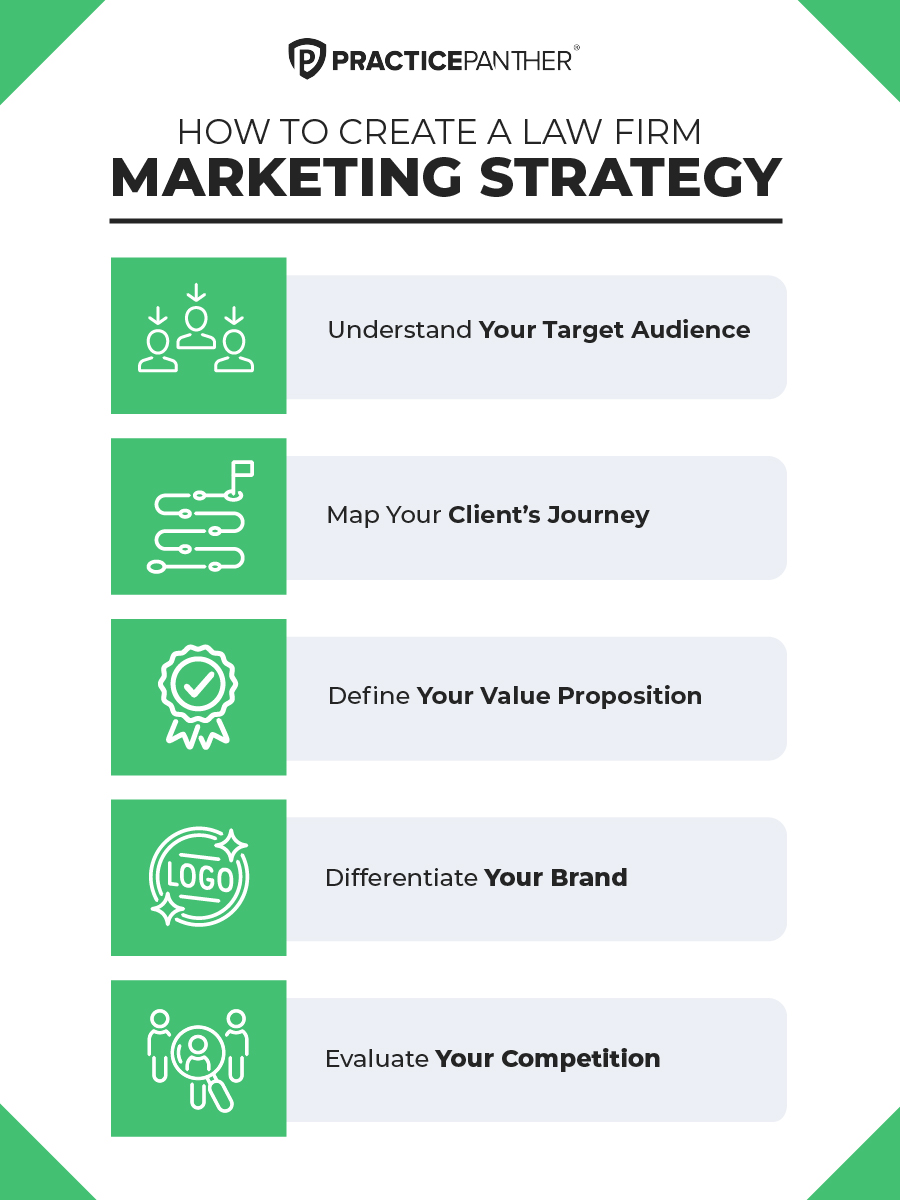How To Create a Law Firm Marketing Strategy

To lay a foundation for an effective law firm marketing strategy, you need to perform five essential tasks:
1. Understand your target audience
2. Map your client’s journey
3. Define your value proposition
4. Differentiate your brand
5. Evaluate your competition
Let’s look at what each of these steps involves:
1. Understand Your Target Audience
There are different areas of law for a reason, so it makes sense that the audiences law firms market will follow suit. For example, a business litigation firm and a pharmaceutical mass tort firm aren’t targeting the same audience. Each audience has different specific needs that will attract them to their respective legal services. Defining your firm’s target audience is one of the most critical steps in developing your marketing strategy. If you’re not reaching the right people in the right way, your efforts will almost always fall short.
Understand who your clients are and their needs, and use this information to create a profile of your ideal client. Ask yourself, are you marketing to:
- Past clients?
- Current clients?
- Industry contacts?
- Other lawyers?
Expand your answers by considering the characteristics of your target client, such as:
- Location
- Age
- Gender
- Income
- Industry
- Job title
- Preferred communication channels
- Interests
- Needs
This information can help you identify your clients, where they are, how to reach them, and what type of message will appeal to them.
In many cases, your target audience can be divided into multiple segments. In this case, you’ll want to create more than one ideal buyer profile. You can then prioritize the segments representing your most profitable opportunities and customize your marketing campaigns for different parts of your client base.
2. Map Your Client Journey
A client journey consists of your clients’ steps as they progress from potential clients to paying, satisfied clients who refer others to your firm. The beginning of the legal client journey can be divided into three main stages:
1. Awareness Stage
In the awareness stage, prospective clients become conscious of your brand. For example, they may hear about your firm from a friend, see your ad on TV, or stumble across your website. At this stage, they may not necessarily even be looking for legal assistance, but you’re on their radar, making them more likely to think of you if they do need a lawyer.
2. Consideration Stage
In the consideration stage, prospects become actively interested in learning more about your firm as they entertain the possibility of hiring you. They may take steps such as browsing your website, subscribing to your social media following and email lists, and reading your firm’s online reviews. If all goes well, this stage culminates with the prospect scheduling an initial consultation.
3. Decision Stage
In the decision stage, clients evaluate the pros and cons of hiring you and decide whether or not your fee is worth it. If they choose to hire you, this stage concludes with the client signing a representation agreement.
At this point, your prospect has become a client, and they enter a new leg of their client journey. Satisfied clients may become loyal, long-term clients and refer you to others, starting the marketing cycle again by bringing new clients into your door.
To optimize your client journey and promote the conversion of prospects into clients, you can create a map of your client journey that identifies desired outcomes for each stage and what procedures you will follow to achieve those outcomes. A client journey map allows you to develop procedures that align with your marketing objectives.
For example, your client journey map should outline your client intake procedures, which are pivotal in persuading new prospects to become clients. Your intake procedures include:
- The actions you take upon initially meeting a new prospect.
- The questions you ask to evaluate the prospect’s needs.
- The follow-up actions you take to convince the prospect to hire you.
Many firms fall short in failing to follow up consistently on initial contacts. A client journey map can help you avoid this oversight and develop effective follow-up procedures which increase prospect conversion rates.
3. Define Your Value Proposition
Your value proposition defines what you can offer your clients to motivate them to choose your law firm over another firm. It forms the heart of the marketing message you seek to communicate to prospects and clients over their client journey.
A strong value proposition should include several core elements:
- What you offer clients
- Why they should want what you offer
- Why they should want it from you instead of another law firm
Your value proposition should be concise enough to deliver over all the media you use to communicate with clients and serve as an effective marketing tool. Think about a statement you could deliver between floors of an elevator or in a tweet on Twitter. Aiming for 90 words or less is a good rule of thumb.
4. Differentiate Your Brand
One purpose of your value proposition is to differentiate your brand from competitors, which is essential for effective marketing. Branding and marketing are the first steps to bolstering your firm’s reputation. It takes planning, time, and a clear vision. You know your firm’s brand and the clients you want. Brand yourself. Good branding starts with you differentiating yourself from your competitors. Focus on what services or personal styles are unique to you and your firm.
Your brand identity should resonate consistently throughout your marketing materials, including your law firm’s website, logo, letterhead, business card, social media profile, and anywhere else you interact with prospects and clients. Creating and documenting formal brand guideline policies and procedures for your marketing team to follow will help you present a consistent image to your target audience, distinguishing your brand from competing firms.
5. Evaluate Your Competition
You need to understand your competitors and their marketing strategies to differentiate your brand from the competition. Analyze who your competitors are, their actions to attract clients, and where their SWOT (Strengths, Weaknesses, Opportunities, and Threats) lie.
Evaluating your competition starts by identifying who your main competitors are. Once you’ve done this, you can gather information on them from sources such as their digital properties and client reviews. Use this information to analyze your competitors’ strengths and weaknesses. Determine where you can gain a competitive advantage and what you should emphasize in your value proposition and marketing campaigns.




